by Marion Patterson | Nov 10, 2022 | Birds, Nature
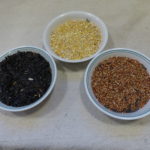
Sunflower seed, cracked corn, milo.
Feeding backyard birds is fun, but it’s become expensive. The price of black oil sunflower seed has doubled in just a couple of years.
To keep our birds well-fed and our budget under control we use Fourth Story Feeders. What are they? Well, the first story is the ground. The second is a picnic table or other platform a few feet off the ground, and the third is a metal shepherd’s hook shoved into the ground that gets feeders up four or five feet. We use all these and increasingly have taken the feed up the elevator to the fourth floor.
Raccoons, deer, opossums, and even bears love a nocturnal snack of expensive bird seed. Squirrels and wild turkeys gobble it up during the day. These animals easily access seeds on the first, second, and third floor – but not the fourth. Except for bears who can create complete havoc with feeders left out overnight.
Here’s how we created a feeding station that’s easy for birds to reach but inaccessible to deer, turkeys, raccoons, and opossums:
- Bought the tallest shepherd’s hook we could find.
- Pulled our homemade picnic table to a spot easy to see through our windows.
- Drilled two holes in the wooden table exactly the size of the “feet” of the shepherd’s hook. Used a hammer to lightly tap the “feet” into the holes.
- Suspended silo and suet feeders from the hooks that are now eight or nine feet above the ground and out of reach of deer and nearly impossible for raccoons and opossums to climb.
-
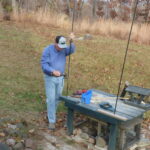
-
A few tools around the home help construct Fourth Floor Feeders
-
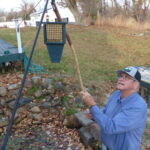
-
A pole with a hook makes lifting feeder high easy.
The birds love eating from the fourth story but there’s a problem. How to fill feeders so high up? Well, again, here’s how we solved the problem:
We scrounged a four-foot-long stick from a nearby lake that a beaver had cut and chewed off the bark. We bought an “S” hook from a hardware store and drilled a hole in the end of the stick. We pressed one side of the “S” hook into the wooden stick and had a handy tool.
With the hook on the stick, we can easily lift a feeder and hang it on the fourth story. A broomstick works as well as a beaver stick and the telescoping metal poles used to attach to paint rollers also can work. Most already have a hook built into the pole.
Squirrels can climb the steel shaft of the shepherd’s hook, but we foil them by coating its surface with a light spray of grease. Baffles are better at keeping these smart, pesky mammals at bay.
Materials Needed
Bird feeders
Picnic table
Shepherd’s Hook feeder holder
Pole for lifting feeder
“S” hookTube of spray grease
Helpful Tools
Drill and bit the same size as the shepherd’s hook’s diameter
Hammer
Although we still offer birdseed on the first, second, and third floors, now we present most of the seeds on the fourth floor. Saves seeds. Saves money. Frustrates deer, raccoons, turkeys, opossums, and squirrels.
-
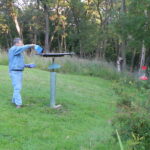
-
Hummingbird and platform feeders with baffle.
-
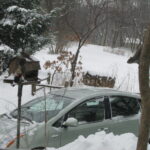
-
Squirrels quickly figure out how to access feeders
by Winding Pathways | May 3, 2018 | Birds, Mammals, Nature
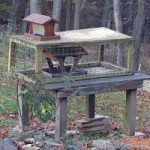
Keeping Squirrels at bay
Bruce Frana, a Winding Pathways visitor, saw one of our blogs on our “squirrel proof” feeder and how we discourage squirrels from gobbling up sunflower seeds we put out for birds. He crafted a similar but much more attractive version that’s in his yard. Our contraption is a box framed with 2X2 lumber with sides of 2” x 2” wire mesh. A piece of plywood forms the roof, and we attached it to a wooden table with a pair of hinges. The hinges let us lift the cage to sprinkle sunflower seeds inside.
It works. Sort of. Cardinals, chickadees, and nuthatches easily pass through the wire mesh to feed. Some squirrels and wild turkeys, which we like but get frustrated when they gobble up all the seed, can’t get through the mesh. Our fox squirrels are too chunky to squeeze through, but smaller gray squirrels manage to get in and gobble seeds. We could keep the grays out if we could find 1 ¾ x 1 ¾ mesh wire on the market. As far as we know it doesn’t exist, but if it did it would let birds in but exclude even the skinniest gray squirrel.
Bruce reports that his fox squirrels can’t enter either but the grays do. Here is a photo of his squirrel foiling feeder:
Do It Yourself “Squirrel Proof” Feeder!
Here is what he shared: “I have had a platform feeder for several years but, like your blog mentioned, turkeys, and even some clever squirrels, were able to get on top of it. I built (a feeder) based on the plan/picture you shared on your blog. I adapted the plan to the platform feeder I had and made some of my own modifications.
“As you can see from the pictures, I attached the structure onto the original platform by using hinges, just as your plan had done. I also put a pitched roof and handle to be able to easily lift the one end to place seed on the platform. The entire system is attached to a 2″ PVC pipe that slides over a steel post. I have had one ingenious small grey squirrel figure out how to get into the feeder and solved that problem, at least for now, by making the wire openings a bit smaller on two sides.” It works…sort of!”
Readers can go online and find “Do It Yourself” (DYI) “squirrel proof” feeder instructions. Good luck and let us know how it goes! Thanks, Bruce Frana.
-
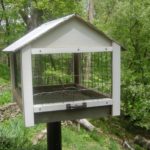
-
Adaptation to feeder
-
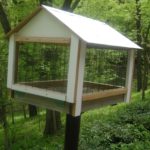
-
Back View of feeder
by Winding Pathways | Dec 14, 2017 | Preparedness
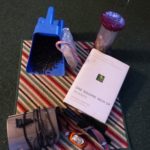
Stocking stuffers that will see use year round.
As the rush for Holiday gifts gets into full swing, we sometimes wonder how to “fill” those stockings with meaningful, fun and inexpensive stuffers. Here are some of Winding Pathways favorite items to be prepared for long dark nights and to simply enjoy cozy winter evenings.
Tops for us are flashlights. I once overheard women talking about how when the power went off one summer night they could not find their way around their own home and didn’t know where their flashlights were. Wow!
While we are adept at and comfortable with finding our way around our home, yard and even motel rooms in the dark, we always have a flashlight with us to use as needed.
Our advice is: First, learn your home, especially in the dark. Good night vision is important. Second, have handy a variety of flashlights and sizes. In the bedroom, bathroom, kitchen, den, and basement. We have small ones at the bedside, backpacker headlamps that fit over stocking caps and large handheld spotlights in strategic places. Remember to check batteries and have extras where you can get them easily.
We are outside a lot, so we like to have plenty of hand warmers with us. Several brands are available and some last longer than others. Some are made to fit into boots and tuck on your back. Anyone who works outside will appreciate a bunch of these. For the winter football fans, you can’t beat the warmers. The paper and mail carriers in your life will surely give a nod of thanks for receiving some warmers. And, those hardy winter bicyclists in your family will love you for including warmers in the stocking.
Because some folks enjoy feeding birds, birdseed and feeders are always great gifts. Use caution and buy quality seed and feeders. You will waste money and attract scavengers if you buy cheap seed loaded with milo, the small reddish seeds in a mix. So, go to a farm store or specialty bird feeding store for higher quality seed and feeders.
A totally practical gift is a weather radio that can be plugged in, run by batteries, or even be powered by a crank. Just Google “weather radio” and choose the one that fits your needs best. With winter upon us, get one!
Of course, many of us like to simply snuggle down on “long winter nights” and read a book. Bookstores are alive with exciting and intriguing books for winter reading. One we have discovered and pored over is One Square Inch of Silence by Gordon Hempton and John Grossmann.
by Winding Pathways | Nov 20, 2016 | Birds, Nature
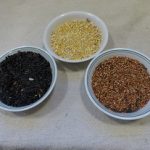
Sunflower seed, cracked corn and Milo mix.
Cold weather in the northern hemisphere and the Holiday Season everywhere are upon us and many gifts for bird lovers fill store shelves. But, shopping for seeds to fill the backyard feeder can be confusing and even frustrating. Many types of seed and mixes are for sale. Some blends are designed to attract specific species, like cardinals, while others target a diversity of birds. Cheap blends appeal mostly to house sparrows and blackbirds, species most people prefer to not attract.
Winding Pathways suggests keeping seed buying simple. We have a favorite seed, one we avoid, and one that we use in a special way. We rarely buy cheap mixes that song birds really do not like and that are sold in big box, chain and grocery stores at inflated prices. Farm stores often sell better mixes at lower cost. Neither of these types of stores have knowledgeable staff to help new comers to winter bird feeding. Specialty bird feeding stores offer the highest quality seed and staff up-to-date in what song birds feed on. And, yes, you pay a bit more – and we find it worth the cost. Less wasted seed and higher satisfaction for homeowners and the birds!
THE BEST SEED FOR WILD BIRDS
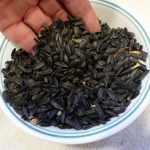
Sunflower delivers the highest quality feed for wintering birds.
Of the many outstanding seeds for feeding birds we like black oil sunflower the best. It’s relatively inexpensive and devoured by chickadees, titmice, nuthatches, woodpeckers, cardinals, and many other species. We don’t mind that birds drop hulls to the ground but for people who dislike this mess, hulled sunflower seed can be purchased and is excellent. It is kernels of larger culinary sunflower seeds, sometimes called gray stripe seed. Hulls have been removed and seed is much more expensive but loved by birds. Most sunflower seeds are produced on farms in the Dakotas and Minnesota.
THE WORST SEED
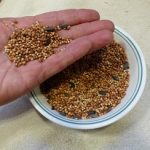
Songbirds do not like the cheap mix.
The worst seed is Milo. It is a common ingredient in cheap mixes and sometimes is sold as “bird seed.” Milo is grown on arid land in the Great Plains and is mainly used for livestock feed. The young plant looks like corn but unlike corn its seeds form at the top of the plant. Few birds like the astringent seeds, although they will sometimes eat it if nothing else is available and they are hungry. Less desirable species, like house sparrows and blackbirds will eat it. Milo seeds are round, slightly reddish, and about twice the size of somewhat similar millet. Try to avoid it.
IN BETWEEN SEEDS
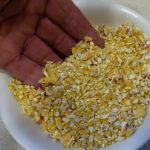
An inexpensive alternative to the higher quality feed.
An excellent inexpensive seed that will be eaten by many birds is cracked corn. Desirable birds prefer sunflower seeds, but we often sprinkle some cracked corn on the ground to keep sparrows and wild turkeys happy and, hopefully, away from our sunflower seed. Another seed of “in between” value is millet. These are tiny round white or yellowish seeds often found in inexpensive mixes. Mourning doves, juncos and other ground feeders enjoy eating it. So do house sparrows.
Learning to identify seeds helps a customer purchase the best seed at the lowest cost. Reading labels helps as most manufacturers list the contents of their seed packages. Happy Holidays to you and the birds you love to feed!
by Winding Pathways | Dec 25, 2015 | Birds, Nature

De-light the tree if you must and adorn it with seed for greater natural delights!
After the holiday cheer fades and ornaments are stored away the Christmas tree can enjoy a second life alive with birds.
Nothing makes a better bird feeder than an upright fir. We take our old tree outside and set it upright. We either use the stand to hold it, dig a hole in the ground deep enough to hold the tree upright, or pound a tall stake into the ground and tie the tree to it. A few strings going out to stakes in the ground will keep it standing in high wind.
Then the fun starts. We pour a couple of cups of birdseed on the very top of the tree and let it settle down into the needles. Larger seeds, like peanuts and gray striped sunflower, work best.
So many birds flock to our tree to find seeds within its branches that it quivers with life and color.
Good sources of seeds include your local feed and wild bird stores, Amazon, Kaytee Products, and Pine Tree Farms, Inc, and of course, many others.














